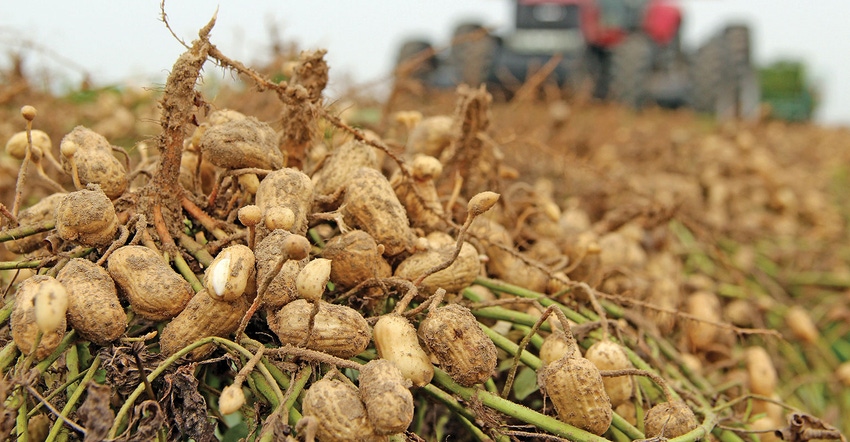
The 2019 Farm Press Peanut Efficiency Award winners relied on rotation, improving soil health, efficient water use, reduced tillage and managing inputs to join the 20th awards class.
Winners Joe and Patricia Morgan, Forrest County, Miss.; Graham Ginn, Calhoun County, Ga.; Jared and Lexi Floyd, Terry, Gaines and Yoakum counties in Texas; and Dennis and Katrine Spruill, Como, North Carolina, will be recognized for their achievements at the annual awards breakfast during the Southern Peanut Growers Conference in Panama City Beach, Fla., in July.
Rotation plays a key role on all four operations. Morgan follows a three-year rotation with cotton. Ginn has been on a two-year program for the past few years but is working toward a three-year rotation with cotton and corn. The Floyd operation includes organic and conventional peanuts in rotation with cotton and corn. Organic peanuts typically go on new ground and they follow with organic cotton or corn. “With organics, you have to rotate,” Jared says.
“We switched from two- to three-year rotations to four- to five-year rotations,” Spruill said. “That made a big difference.” In addition to peanuts, they plant corn, cotton and soybeans.
See Photo Gallery, Joe Morgan wins 2019 Mid-South Peanut Efficiency Award
Soil Health
Enhancing soil health plays significant roles in these operations.
Ginn plants cover crops — wheat and rye with the occasional radish on some acres. He strip-tills corn and cotton and plants peanuts conventionally.
The Spruills use strip tillage on sandier land, which saves trips across the field. On heavier land, they plant on beds. For strip-tilled peanuts, they use a cover crop, which Spruill says helps with thrip pressure.
“Strip-tilled peanuts are cheaper to plant than bedded peanuts so that saves on trips across the fields, which helps us control costs,” he adds.
See Photo Gallery, Spruills make sure each peanut expense counts
The Floyds spread compost on their organic soil. “I’ve learned I get higher yields the second year after I’ve applied the compost,” Jared says.
“I put on 4,000 pounds the first year and 4,000 pounds the second year, and I don’t know why, but the second year always has higher yields.”
Morgan runs a vertical tillage rig over peanut fields, follows with a harrow to help smooth out the ground, and runs a strip tiller before the planter. With this system “our ground has gotten much more mellow. The ground is so fertile, I don’t have to fertilize my peanuts — which is a savings.”
He credits chicken litter for his good soil pH, which averages around 6.8. “I rarely have to spread lime,” he says.
Water management
The declining Ogallala Aquifer forced the Floyds to become creative in farming and water management. They cut back on the number of acres they irrigate but increased the number of acres they farm. “I’ve learned it takes more land to farm the same number of acres, so you can push the water to those acres,” says Jared.
“I’m going to have 170 acres of organic peanuts and 220 acres of two-in-one cotton. I also have space to run cows. So, I’m taking this whole section of land and pushing more water to the 170 acres compared to the 220 acres of organic cotton and making more money.”
Ginn uses soil sensors in some fields and AgSense to pull information together so he can use it to make management decisions. He uses Irrigator Pro to schedule irrigation and make sure his irrigated peanuts do not stress from lack of water and to assure active uptake of his systemic products.
Last year Ginn grew 286 acres of irrigated peanuts and 80 acres of non-irrigated.
See Photo Gallery, Ginn family pushes peanut efficiency through troubled season
The Spruills plant all dryland peanuts. Strip tillage and cover crops, they say, help conserve water on peanut acreage.
Other efficiency measures the 2019 PEA winners employ include RTK guidance systems, using consultants to advise on proper pest management, selecting the best varieties for specific fields or markets, and applying fertilizer based on soil sampling — including grid sampling and variable rate application in some cases.
Good Yields
They all push for good yields. Ginn averages 5,471 pounds per acre on irrigated and 4,271 pounds per acre on non-irrigated land.
The Floyds five-year conventional peanut yield averages nearly 4,000 pounds; the three-year average on irrigated organic peanuts has been about 3,900 pounds. In 2018, the organics sold for $1,200 per ton, while the conventionals brought $400 per ton.
See Photo Gallery, Brownfield, Texas, couple named Peanut Efficiency winners
Over the last five years, Morgan averaged 944 acres a year to peanut production. His five-year yield average is 5,976 pounds an acre.
“Peanut varieties are the best they’ve ever been,” Spruill says. “We’re now averaging 5,000 pounds per acre. We used to hope to get 4,000 pounds.”
“For 20 years, we have sought the best, most efficient peanut producers we could find,” says Marshall Lamb, head of the USDA National Peanut Laboratory in Dawson, Ga., and administrator for the PEA program.
“This year marks the first year for a Mid-South award and Joe Morgan is an excellent addition to this class. Once again, these producers represent the best of the best as they demonstrate high standards in production, efficiency and stewardship.”
About the Author(s)
You May Also Like






